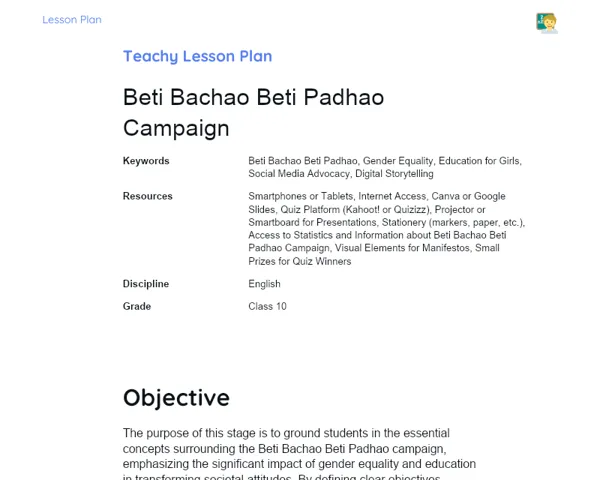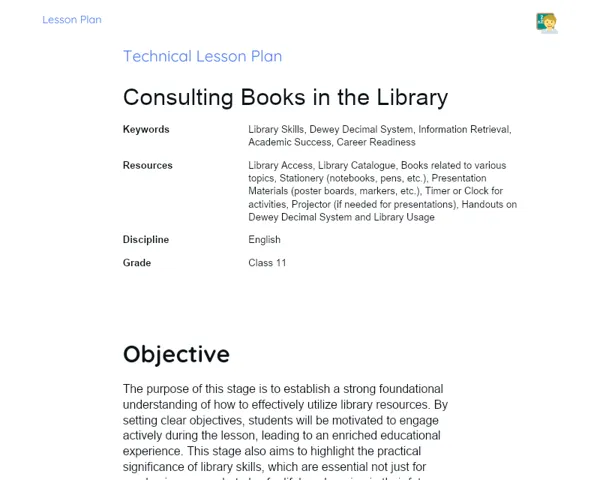Lesson Plan | Active Methodology | Structure of a Book Review
| Keywords | Book Review, Structure, Active Learning, Collaboration, Creativity, Critical Thinking, Expression, Opinion, Engagement, Dramatization, Posters, Debate, Communication Skills, Literary Analysis, Group Activities |
| Necessary Materials | Chart paper, Art supplies (colours, markers, glue), Props for dramatizations (hats, costumes, etc.), Books for reference and review, Projector (if available for multimedia presentations), Timer for managing activity durations, Space for group discussions and performances, Whiteboard and markers for group brainstorming |
Premises: This Active Lesson Plan assumes: a 100-minute class duration, prior student study both with the Book and the beginning of Project development, and that only one activity (among the three suggested) will be chosen to be carried out during the class, as each activity is designed to take up a large part of the available time.
Objectives
Duration: 10 - 15 minutes
This stage aims to set clear expectations for students regarding the skills they will develop through the lesson. By defining both main and secondary objectives, students can focus on understanding the specific elements that comprise a well-organized book review. This clarity ensures engagement and guides learners in applying their previous knowledge effectively during practical activities.
Main Objectives:
1. Enable students to identify and articulate the key components of a book review.
2. Enhance students' abilities to express opinions and analyses in a structured format.
Side Objectives:
- Encourage creativity in presenting personal insights about the stories and characters.
Introduction
Duration: 15 - 20 minutes
The purpose of this stage is to engage students by presenting relatable problem situations that not only revisit their prior knowledge but also motivate them to apply what they've learned. Contextualizing the lesson helps students recognize the practical relevance of book reviews in their own lives, making the learning experience more meaningful and engaging.
Problem-Based Situation
1. Imagine two friends, Ravi and Priya, have just read the same book. Ravi thinks it's the best thing he's ever read, while Priya believes it was boring. How can they share their differing opinions effectively without arguing?
2. In a book club meeting, the members need to select which book to read next. Each member must present their review of a book they recently read to convince others why it should be chosen. How can they structure their reviews to be persuasive and engaging?
Contextualization
Book reviews play an essential role in today's world, especially with the rise of social media and online platforms like Goodreads and Bookstagram. Students must understand that a well-organized book review not only shares thoughts but also helps others decide whether a book is worth reading. Engaging in this process can spark discussions around themes, characters, and messages that resonate with their own lives. Additionally, reviewing books can enhance their writing skills and critical thinking, making it a fun yet educational exercise.
Development
Duration: 70 - 80 minutes
The purpose of this stage is to engage students actively in the learning process by allowing them to collaborate in groups to tackle creative challenges related to book reviews. By selecting one of the suggested activities, students can apply their knowledge in a fun and dynamic way, reinforcing the importance of structure and personal opinion in book reviews while fostering teamwork and creativity.
Activity Suggestions
It is recommended that only one of the suggested activities be carried out
Activity 1 - Book Review Drama! 🎭
> Duration: 60 - 70 minutes
- Objective: To allow students to creatively express their understanding of a book’s structure and their opinions through a fun, interactive skit while enhancing communication skills.
- Description: In this engaging activity, students will stage a short dramatization based on a book they have read. Each group will select a book and create a brief skit that summarizes the plot and highlights the main characters and themes. They will also include their personal opinions about the book, mimicking a live book review. The dramatization should last between 3 to 5 minutes. Props can be used creatively to enhance the performance, making it both fun and informative.
- Instructions:
-
Divide the class into groups of up to 5 students.
-
Each group selects a book they have read from a provided list or one they are familiar with.
-
Groups discuss the key components of their book, including plot, characters, themes, and their personal opinion.
-
Students brainstorm ways to present these elements in a dramatized form, writing a simple script.
-
Allocate time for rehearsals, reminding groups to focus on clarity in their reviews.
-
Each group performs their skit in front of the class, engaging the audience by asking questions or inviting them to provide their own opinions.
Activity 2 - The Book Review Poster Challenge! 📚🎨
> Duration: 60 - 70 minutes
- Objective: To combine artistic expression with literary critique, helping students articulate their thoughts on a book in a creative format while learning to summarize and review.
- Description: In this creative project, students will design a poster for a book they have read. The poster must include a summary of the book, illustrations, and a section for their personal review. This allows students to mix visual arts with literary analysis, encouraging creativity while reinforcing the structure of a book review.
- Instructions:
-
Form groups of 5 students and distribute large sheets of chart paper and art supplies.
-
Students select a book they have all read and brainstorm on what to include on the poster.
-
Each group divides roles: one member can sketch illustrations, another writes the summary, and others can pen down their reviews.
-
Allocate time for creating the poster and ensure that all group members collaborate effectively.
-
Each group presents their poster to the class, explaining the book’s structure and their personal opinions.
Activity 3 - Book Review Debate! 🗣️⚖️
> Duration: 60 - 70 minutes
- Objective: To develop students' skills in argumentation, critical thinking, and structured expression of opinions about literature, enhancing their understanding of a book's value.
- Description: In this thrilling debate activity, students will take opposing views on a particular book. Each group will argue either for or against a specific book's merits, focusing on the strengths and weaknesses identified from their readings. This activity fosters critical thinking, persuasive speaking, and engagement in friendly rivalry, making the lesson dynamic.
- Instructions:
-
Divide the class into two larger groups, assigning one group to argue in favor and the other against a chosen book.
-
Groups will have time to prepare their arguments, focusing on elements like plot, character development, and themes.
-
Encourage students to include personal opinions and supporting examples from the book to strengthen their debate.
-
Conduct the debate, allowing each side to present their arguments and rebuttals, followed by a class vote on which side presented a more compelling review.
-
Wrap up with a discussion on how the arguments highlighted various aspects of writing a book review.
Feedback
Duration: 15 - 20 minutes
The purpose of this feedback stage is to encourage students to articulate what they have learned from their practical activities. This group discussion allows them to reflect on their experiences, share insights, and reinforce their understanding of the components of a book review. By engaging in this dialogue, students can deepen their comprehension and appreciate different perspectives, enhancing the overall learning experience.
Group Discussion
Let's gather around and share our experiences! Each group has put in a lot of effort in their presentations, and it’s important to reflect on what we’ve learned together. I invite each group to share one key takeaway from their activity and discuss how it helped them understand the structure of a book review better. This is a chance for everyone to listen, learn, and appreciate each other's insights!
Key Questions
1. What are the most important elements of a book review, and how did your activity help you understand them?
2. How did working collaboratively in your groups enhance your understanding of expressing personal opinions?
3. In what way do you think your skit, poster, or debate influenced your perspective on the book you reviewed?
Conclusion
Duration: 10 - 15 minutes
The purpose of this conclusion stage is to consolidate the learning experience by summarizing the key takeaways from the lesson, highlighting the connection between the theoretical aspects of book reviews and their practical applications. This closure reinforces the importance of effective communication and critical thinking, encouraging students to carry these skills into their everyday interactions.
Summary
In this lesson, students engaged in exploring the essential components of a book review, including elements such as plot, characters, themes, and personal opinions. Through various interactive activities such as dramatizations, posters, and debates, they creatively expressed their understanding and showcased their ability to articulate thoughts in a structured manner. This practical approach reinforced both the theoretical knowledge and the application of writing a book review.
Theory Connection
The lesson effectively connected theory with practice by allowing students to apply their pre-learned concepts about book reviews in real-life scenarios. They learned how to structure their thoughts logically while also encouraging their creativity and personal expression. By participating in group activities, students experienced firsthand how reviews can influence readers' perceptions and choices regarding books, thereby solidifying their understanding of the topic.
Closing
Understanding how to write a book review is not only a valuable skill in academic settings but also an essential tool in everyday life. It empowers individuals to express their opinions clearly and persuasively, whether sharing thoughts with friends on social media or recommending a good read in informal conversations. Mastering the art of book reviews fosters critical thinking and enhances communication skills, which are vital for personal growth and social interaction.



